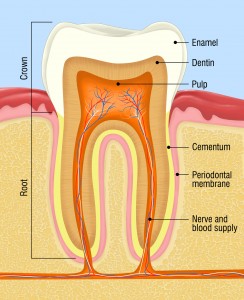 You know your teeth are an important part of your overall health and well-being. But, do you know what’s really going on underneath that shiny white surface? Let’s dig deep to find out about all of the different structures and components that keep your teeth strong and healthy.
You know your teeth are an important part of your overall health and well-being. But, do you know what’s really going on underneath that shiny white surface? Let’s dig deep to find out about all of the different structures and components that keep your teeth strong and healthy.
Crown: This is the part that sticks up above the gum line. The crown has the most exposure to environmental elements such as the foods and beverages you consume, as well as cigarette smoke and other substances that may be consumed or inhaled.
Enamel: This is the shiny, hard outer shell that covers the crown of the tooth. Although it’s one of the hardest substances in the human body, it’s still prone to degradation due to acids and bacteria in your mouth. The enamel can’t be restored once it’s gone, so be sure to rinse your mouth with water after consuming sweet or acidic foods, and remember to brush regularly to prevent cavities and enamel erosion.
Root: This is the part of the tooth that runs from the gum line into the jawbone. A tooth can have anywhere from one to three roots, depending on which tooth it is. The root contains the root nerve, which runs into the jawbone as well. When you have a root canal procedure, the dentist will go down into this area to remove the nerve, which means the tooth will no longer feel pain.
Dentin: Dentin is a layer of bony tissue underneath the enamel. Dentin has lots of small channels, or tubules, that run through it into the nerve chamber. When your enamel wears away, the tubules are exposed, which causes pain to transmit more readily (and more powerfully) to the nerve.
Pulp: Pulp resides under the dentin and makes up the core of your tooth. The pulp is made up of blood and lymph vessels as well as nerve tissues. This material provides nutrients to the rest of the tooth to help keep it strong, and it plays an important role in sensing temperature and pain. When the pulp becomes infected or damaged, it is removed as part of the root canal procedure.
Cementum: Cementum is another kind of tissue that protects the roots much like enamel protects the crown of the tooth. Cementum is thinner and less hard than enamel, but it has lots of little fibers that help anchor the tooth to the surrounding bone.
Periodontal Membrane: This soft, fleshy tissue makes up the tooth socket and helps anchor the tooth in your mouth as well as to your other teeth. The periodontal membrane, also called the periodontal ligament, creates a cushioning effect, which helps your teeth withstand the pressure of chewing.
Nerve and Blood Supply: The nerve runs from the pulp chamber in the middle of your tooth down through each of the roots and into your jaw. The blood supply for each tooth also runs through the roots and up into the pulp chamber. The nerve and blood supply is critical for a developing tooth but isn’t entirely necessary once the tooth emerges. This is why a tooth can remain in your mouth even after the nerve and blood supply are removed during a root canal procedure, as an adult tooth has all of the components and properties it needs to function on a daily basis.
The tooth is a pretty interesting little structure, huh? Of course we find teeth fascinating here at DentaLux, but we hope you were intrigued by this little primer as well!







Leave a Reply